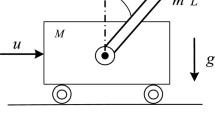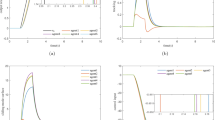Abstract
This study aims to devise an adaptive model-free fault-tolerant control system based on sliding mode theory for the trajectory tracking of an autonomous underwater vehicle (AUV) equipped with four rotatable thrusters. The proposed control system addresses challenges such as actuator faults, dynamic uncertainty, and time-varying exogenous disturbances. Ensuring the boundedness of the switching gain and achieving uniformly ultimately bounded performance necessitates a priori boundedness of the uncertainty. To address these requirements, a novel control framework is developed by integrating sliding mode and adaptive control techniques for AUV trajectory tracking missions. The effectiveness of the controller is assessed in the presence of partial loss of effectiveness, bias faults, and complete failure of a rotatable actuator. To manage the absence of one actuator, the elimination of column method is introduced into the actuator distribution. The proposed model-free fault-tolerant structure significantly enhances the system reliability. Numerical results validate the efficacy of the proposed methodology in successfully handling the total failure of a single actuator.















Similar content being viewed by others
References
Londhe PS, Santhakumar M, Patre BM, Waghmare LM (2016) Task space control of an autonomous underwater vehicle manipulator system by robust single-input fuzzy logic control scheme. IEEE J Ocean Eng 42(1):13–28
Yu H, Guo C, Yan Z (2019) Globally finite-time stable three-dimensional trajectory-tracking control of underactuated UUVs. Ocean Eng 189:106329
Qiao L, Zhang W (2018) Adaptive second-order fast nonsingular terminal sliding mode tracking control for fully actuated autonomous underwater vehicles. IEEE J Ocean Eng 44(2):363–385
Mazare M (2023) Reconfigurable tolerant control of nonlinear Euler–Lagrange systems under actuator fault: a reinforcement learning-based fixed-time approach. Aerosp Sci Technol 142:108631
Mazare M, Taghizadeh M (2022) Uncertainty estimator-based dual layer adaptive fault-tolerant control for wind turbines. Renew Energy 188:545–560
Kadiyam J, Parashar A, Mohan S, Deshmukh D (2020) Actuator fault-tolerant control study of an underwater robot with four rotatable thrusters. Ocean Eng 197:106929
Gong P, Yan Z, Zhang W, Tang J (2021) Lyapunov-based model predictive control trajectory tracking for an autonomous underwater vehicle with external disturbances. Ocean Eng 232:109010
Oyang H, Lin Y (2017) Adaptive fault-tolerant control for actuator failures: a switching strategy. Automatica 81:87–95
Cui R, Zhang X, Cui D (2016) Adaptive sliding-mode attitude control for autonomous underwater vehicles with input nonlinearities. Ocean Eng 123:45–54
Zhou H, Wei Z, Zeng Z, Yu C, Yao B, Lian L (2020) Adaptive robust sliding mode control of autonomous underwater glider with input constraints for persistent virtual mooring. Appl Ocean Res 95:102027
Esfahani HN, Szlapczynski R, Ghaemi H (2019) High performance super-twisting sliding mode control for a maritime autonomous surface ship (MASS) using ADP-based adaptive gains and time delay estimation. Ocean Eng 191:106526
Liu X, Zhang M, Yao F (2018) Adaptive fault tolerant control and thruster fault reconstruction for autonomous underwater vehicle. Ocean Eng 155:10–23
Qiao L, Zhang W (2018) Double-loop integral terminal sliding mode tracking control for UUVs with adaptive dynamic compensation of uncertainties and disturbances. IEEE J Ocean Eng 44(1):29–53
Aghaeinezhad SM, Taghizadeh M, Mazare M, Kazemi MG (2021) Individual pitch angle control of a variable speed wind turbine using adaptive fractional order non-singular fast terminal sliding mode control. Int J Precis Eng Manuf 22:511–522
Plestan F, Shtessel Y, Bregeault V, Poznyak A (2010) New methodologies for adaptive sliding mode control. Int J Control 83(9):1907–1919
Zeinali M, Notash L (2010) Adaptive sliding mode control with uncertainty estimator for robot manipulators. Mech Mach Theory 45(1):80–90
Zhu C, Bing H et al (2021) Adaptive model-parameter-free fault-tolerant trajectory tracking control for autonomous underwater vehicles. ISA Trans 114:57–71
Kadiyam J, Parashar A et al (2020) A ctuator fault-tolerant control study of an underwater robot with four rotatable thrusters. Ocean Eng 197:106929
Mazare M, Taghizadeh M, Ghaf-Ghanbari P (2020) Fault-tolerant control based on adaptive super-twisting nonsingular integral-type terminal sliding mode for a delta parallel robot. J Braz Soc Mech Sci Eng 42(8):1–15
Shen Q, Jiang B, Cocquempot V (2014) Adaptive fuzzy observer-based active fault-tolerant dynamic surface control for a class of nonlinear systems with actuator faults. IEEE Trans Fuzzy Syst 22(2):338–349
Shao X, Hu Q, Shi Y et al (2018) Fault-tolerant prescribed performance attitude tracking control for spacecraft under input saturation. IEEE Trans Control Syst Technol
Liao Y, Du T, Jiang Q (2019) Model-free adaptive control method with variable forgetting factor for unmanned surface vehicle control. Appl Ocean Res 93:101945
Kong FH, Manchester IR (2020) Contraction analysis of nonlinear noncausal iterative learning control. Syst Control Lett 136:104599
Woo J, Yu C, Kim N (2019) Deep reinforcement learning-based controller for path following of an unmanned surface vehicle. Ocean Eng 183:155–166
Koch W, Mancuso R, West R et al (2019) Reinforcement learning for UAV attitude control. ACM Trans Cyber Phys Syst 3(2):1–21
Zhu C, Huang B, Zhou B, Yumin Su, Zhang E (2021) Adaptive model-parameter-free fault-tolerant trajectory tracking control for autonomous underwater vehicles. ISA Trans 114:57–71
Qin H, Chen H, Sun Y (2020) Distributed finite-time fault-tolerant error constraint containment algorithm for multiple ocean bottom flying nodes with tan-type barrier Lyapunov function. Int J Robust Nonlinear Control 30(13):5157–5180
Shen Z, Bi Y, Wang Y et al (2020) MLP Neural network-based recursive sliding mode dynamic surface control for trajectory tracking of fully actuated surface vessel subject to unknown dynamics and input saturation. Neurocomputing 377:103–112
Gao J, An X, Proctor A et al (2017) Sliding mode adaptive neural network control for hybrid visual servoing of underwater vehicles. Ocean Eng 142:666–675
Yan Z, Wang M, Xu J (2019) Robust adaptive sliding mode control of under actuated autonomous underwater vehicles with uncertain dynamics. Ocean Eng 173:802–809
Zhu Z, Duan Z, Qin H (2023) Adaptive neural network fixed-time sliding mode control for trajectory tracking of underwater vehicle. Ocean Eng 287:115864
Zhang Y, Sun J, Liang H, Li H (2018) Event-triggered adaptive tracking control for multiagent systems with unknown disturbances. IEEE Trans Cybern 50(3):890–901
Qinmin Y, Ge Sam S, Sun Y (2015) Adaptive actuator fault tolerant control for uncertain nonlinear systems with multiple actuators. Automatica 60:92–99
Fossen TI (1994) Guidance and control of ocean vehicles. Wiley, Chichester
Yang J, Su J, Li S, Yu X (2014) High-order mismatched disturbance compensation for motion control systems via a continuous dynamic sliding-mode approach. IEEE Trans Ind Inform 610:604–614
Cheng Z, Bing H, Bin Z, Yumin S, Enhua Z (2021) Adaptive model-parameter-free fault-tolerant trajectory tracking control for autonomous underwater vehicles. ISA Trans 114:57–71
Negrete-Chávez DY, Moreno JA (2016) Second-order sliding mode output feedback controller with adaptation. Int J Adapt Control Signal Process 30(8–10):1523–1543
Nasiri A, Nguang SK, Swain A (2014) Adaptive sliding mode control for a class of MIMO nonlinear systems with uncertainties. J Frankl Inst 351(4):2048–2061
Mazare M, Tolu S, Taghizadeh M (2022) Adaptive variable impedance control for a modular soft robot manipulator in configuration space. Meccanica 57(1):1–15
Edwards C, Shtessel YB (2016) Adaptive continuous higher order sliding mode control. Automatica 65:183–190
Mazare M (2023) Reinforcement learning-based fixed-time resilient control of nonlinear cyber physical systems under false data injection attacks and mismatch disturbances. J Franklin Inst 360(18):14926–14938
Utkin VI, Poznyak AS (2013) Adaptive sliding mode control with application to super-twist algorithm: equivalent control method. Automatica 49(1):39–47
Author information
Authors and Affiliations
Corresponding author
Additional information
Technical Editor: Adriano Almeida Gonçalves Siqueira.
Publisher's Note
Springer Nature remains neutral with regard to jurisdictional claims in published maps and institutional affiliations.
Appendix
Appendix
According to property 1, \(\Vert M\Vert ,\Vert C\Vert ,\Vert D\Vert\) and \(\Vert G\Vert\) satisfy property 2. Therefore, Eq. (15) is further introduced as:
By defining \({\rm E}={\left[\begin{array}{cc}e& \dot{e}\end{array}\right]}^{T},\Vert e\Vert \le \Vert E\Vert \&\Vert \dot{e}\Vert \le \Vert E\Vert\), Eq. (34) can be rewritten as follows:
In Eq. (21), \({\Omega }_{i}\) represents unknown terms, and it is important to note that Assumption 3 does not impose a priori bounds on the lumped term.
Rights and permissions
Springer Nature or its licensor (e.g. a society or other partner) holds exclusive rights to this article under a publishing agreement with the author(s) or other rightsholder(s); author self-archiving of the accepted manuscript version of this article is solely governed by the terms of such publishing agreement and applicable law.
About this article
Cite this article
Mokhtari, M., Taghizadeh, M. & Mazare, M. Adaptive model-free fault-tolerant control for autonomous underwater vehicles subject to actuator failure. J Braz. Soc. Mech. Sci. Eng. 46, 330 (2024). https://doi.org/10.1007/s40430-024-04860-8
Received:
Accepted:
Published:
DOI: https://doi.org/10.1007/s40430-024-04860-8




